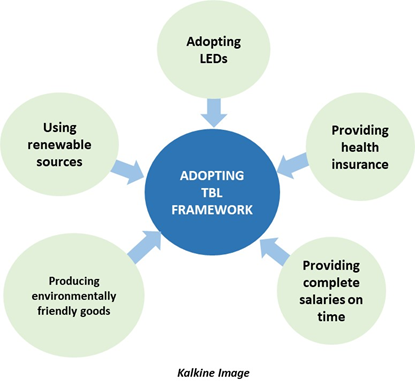Triple Bottom Line is an accounting approach that focuses on creating a sustainable method of execution for corporates. It is an economic concept that includes three aspects in its functioning: social, environmental, and financial.
This approach suggests that there should not be one but three bottom lines that a company adheres to. These three bottom lines include the people, planet, and profits or the 3Ps. All the aspects covered under the Triple Bottom Line approach are not included in traditional accounting methods as they cannot be measured as easily.
Corporates are expected to follow TBL methodology under their Corporate Social Responsibility. The purpose of adopting TBL is same for companies. However, how this approach is adopted differs across organisations.

How did this approach come into existence?
The phrase Triple Bottom Line was coined in 1994 by British sustainability expert John Elkington. The idea was to move beyond the general method of accounting followed by companies that focuses majorly on revenues and profits.
The ideology states that companies should focus on three bottom lines.
- The first bottom line being the traditional method of accounting which includes the profit and loss statement of a company.
- The second bottom line being the “people’s account”, which states how socially responsible a company has been.
- Finally, the third bottom line being the company’s planet account, which depicts whether the company has taken environmentally conscious decisions or not.
The idea was given birth to so that people take a long and deep look into capitalism and what its future entails. However, it is widely understood as a tool to manage accounts in areas beyond company revenues. It is also understood as an improvement over the traditional single bottom line bookkeeping method followed by companies.
Over time the concept has branched into more extensions like the Quadruple Bottom line, and it has been interpreted differently across organisations.
How does the Triple Bottom Line incorporate the 3Ps?
The sustainability approach focuses on the following aspects:
- People: Companies have an obligation towards all the stakeholders in the company. Therefore, a company must look after all individuals associated with it, including all its employees and customers. The TBL ideology recognises the interdependencies existing between various sets of people associated with the organisation.
Thus, organisations must foster a hospitable environment for all individuals that are linked with it. This can be achieved through favourable employee benefits and/or by ensuring customer satisfaction is achieved through regular feedbacks.
- Planet: This includes adopting environmentally conscious decisions during the manufacturing process as well as through further stages. These decisions may include not producing harmful products, reducing waste and harmful emissions, and adopting renewable energy sources.
- Profits: A company’s profit and loss statement is one of the most important aspects on which its operations are based. The TBL approach ensures that various aspects associated with the company do not suffer as the company tries to generate profits. Thus, measures that are ecological and profitable are preferred over traditional means of revenue creation.
What are the challenges associated with TBL method?
A major issue faced by companies in adopting the TBL approach is measuring the aspects it seeks to integrate into the bottom lines. Out of the three bottom lines, profits can easily be measured in terms of money; however, the rest cannot be readily measured.
One method to overcome this can be to find out the monetary value of all the three bottom line aspects. For instance, attaching a standard monetary value to a single carbon footprint can help determine the cost caused by a company to the environment. Similarly, whether a company’s policies are employee friendly or not can be judged by the monetary value of the benefits provided to the employees.
Another method to achieve this can be through appropriate indexes that help companies measure how they impact the environment as well as the stakeholders. This is highly dependent on the framework followed by a company. Thus, in practice, this would lead to multiple variations across companies. There is no standard index that would fit universally.

How can organisations move towards the TBL framework?
The Triple Bottom Line approach can be adopted by companies, non-profits and even government organisations. Adopting the approach entails the initiation of a few small steps that would help ensure that are more sustainable and provide a wider coverage among individuals.
Even small initiatives like switching from incandescent bulbs to LED bulbs would be a good start in moving towards the TBL approach. This can be followed by slightly bigger projects that are aimed at using renewable sources of technology and producing goods that are environmentally friendly.
Next step would be to focus on employee policies. Employees must receive salaries promised to them on time. Providing health insurance to employees and other necessary benefits would give the workers a sense of security and would enable them to offer their best to the company.
Reusing inventory or unused parts in the following financial year is also another method of adopting a more sustainable approach. Thus, the TBL method allows companies to focus on much more than just monetary revenue. It has been crucial in the current times when a lot is dependent on an organisation’s reputation. Thus, all dimensions that enable a business to function must be treated respectfully, and the TBL approach is one such measure that helps organisations achieve the same.
 Please wait processing your request...
Please wait processing your request...